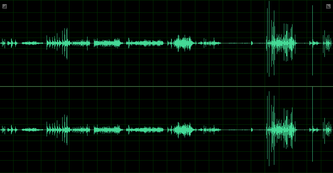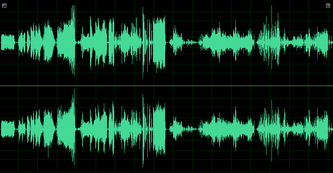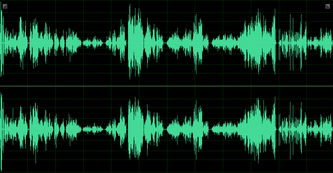|
Notes for refinement based on the improvisation process so far:
-often leaving loops playing for too long -most of the first 6 recordings did not feature much prominent performative FX tweaking, sample micro-looping, granular-suspension -tended to either be spacey and fragmented, or totally reliant on loop sync. Would like a balance of both -need to do some pre-preparation of ‘sections’ of musical material, so can easy change from one to the next and stay in flow -often turning up high pitched samples too loud for too long, they generally don’t need to be as loud as the rest -volume dynamics always slow, or immediate cuts. Other dynamics speeds, and techniques like swells and fluctuations -not using any panning techniques – static or dynamic – on samples or FX -not being bold with FX, not experimenting with new techniques and combinations -apart from glitch sounds, otherwise all high fidelity – explore low fidelity in other aspects – perhaps process samples in Audition, or get some of the dirtier mixdowns, and explore the textures of noise floors, etc -reveal the inner working of the technology through the music – travel further away from sounding like acoustic recordings -lack of rhythmic samples and combined samples in the collection – do a few Audition sessions of editing together rhythms and combining rhythms of different instruments together The sample editing process was finally completed after many hours and days of intricate work.
Final count - 381 individual samples (gleaned from just under an hour of raw studio recordings). And that's just on the first pass. If I went over those recordings again, I could easily double that number. And it's interesting to consider what would happen if someone else edited samples out of those same recordings, how their interpretation would differ. Anyway, 381 samples is huge. That could keep me going for years. But in the interests of diversity, as I continue to develop this project in the future I aim to expand the array of instruments and personalities used. My consideration now is categorizing the samples for quick and easy discovery before and during performance. For now I just use the Mac Finder - where my samples are arranged by instrument type, but it is not at all ideal. I have heard rumour of someone developing a visual system where samples can appear as nodes that float around, and can be clumped together based on meta-data or audio analysis -- for example instrument type, melodic/rhythmic, sample length, loudness, timbral characteristics etc. So you select one of these elements from a menu, and a cluster of relevant samples forms. Ideally then, I'd just drag and drop these sample-nodes into my instrument and play. Above are the waveforms for each studio session. All recordings were done in Pro Tools HD at the Elder Conservatorium's Electronic Music Unit and mixed-down in Adobe Audition.
I've included these images because they give an instant insight into of the performers' responses to the idea of improvising with "breathing space" between musical gestures... Some could clearly flow out of the silence into a gesture, then roll off into silence again... Some climbed onto an idea, rode it for a while, then climbed off, stopped, and climbed onto the next one... Some transformed a continuous stream of sound-world... ...and some of the performers moved between all these ways of playing. Audio Processing Initially Audition was used for the mixdowns simply because I didn't have Pro Tools on my laptop, but I also found that it provided a much smoother workflow for managing the intricacies of waveform editing. There was a long process of editing out extraneous sounds in the circuit recording and mic clipping in the electric guitar recording. This was done quickly and roughly (as the second phase of sample editing will be intricate and precise), but Audition seamed the sounds together with exceptional ease. Both the circuit and piano recordings were processed with Audition's Noise Reduction. As discussed below, this resulted in audible frequency erosions in the circuit recording, but seems to have cleaned up a hum in the piano recording incredibly well, with no audible degradation. The waveforms were normalized, but no effects processing will be done until the next phase where they are edited into sample fragments ready for performance. What is Streamland?
"Gleaning Improvisational Raw Materials from Performers Towards Streamlined Sample-Based Music Production" It's basically a three-step process: 1) I record 5 solo performers improvising in the studio for 5-10 minutes 2) I edit these recordings into samples 3) I perform laptop improvisations using only these samples The idea was born out of long consideration of sampling and copyright issues. Since 2000 I had been sampling commercial material to make most of my music, so copyright had always been an issue preventing me from distributing this music. Using a DAW with a huge sample library (like Logic) was not a satisfactory solution, as the samples generally felt too hi-fi, too clean, and too impersonal for my style of sampling. So I considered for a long time how to continue to work in the collage style I loved the most, using materials that were copyright free but still resonated with me on a personal level. Streamland was the solution I eventually came to. I realized that I finally had a diverse range of musician contacts in my network to enable me to sample a great variety of personalities, instruments and styles. I had the skills in the studio to get quality recordings, and I had the skills to design and adapt my own software to suit this style of laptop performance. So what I'm broadly aiming for is to create a streamlined framework for sample-based improvisation (and in the future, production and composition) - streamlined not in a production-line-efficiency way, but in the sense of creating a clear channel for inspiration to flow. Recording sessions are short, no preparation on the part of the performer is necessary, samples are edited for infinite re-use, re-contextualizing, manipulation, FX, etc. and laptop improvisations will require minimal setup time and no post-production work. Aims The aims of this project are in two phases: Phase One: To engage with improvising musicians in the context of sampling – i.e. musicians who are playing with express knowledge that they will be sampled. It is anticipated that from one recording session to the next, I will better learn how to communicate to performers how to gear their playing toward the needs of my style of sampling, in a way that is empathic to their needs for the expression of their unique voices as performers. This also feeds into generating a pool of samples for life-long use that involve a personal journey of collaborative synergy. Phase Two: To consistently achieve complete and polished pieces through my electronic improvisations – a natural and streamlined workflow. Aside from preparing some audio effects that I’ll be manipulating as I perform, and choosing some (not necessarily all) of the samples I’ll use before I begin, no other pre or post-production work will be undertaken. However, I will put no restrictions on my sample use – e.g. re-using the same or a similar palette of samples, emulating a previous improvisation to refine the result, combining performative ideas from various improvisations, and sampling my own explorations. These are all relevant processes, as one of the main focuses of this work is familiarizing myself and creatively harmonizing with the samples to explore their potentials, and by its nature sampling is a deeply repetitious and iterative form of music making – for example, repeating a recorded fragment of a series of notes re-iterates so much more information than repeating a series of notes on a real instrument, and iterative because samples are often re-processed, re-contextualized, and re-recorded over and over, often to the point of unrecognizability. Context Streamland was initiated as a third year research project at the University of Adelaide's Elder Conservatorium. The plan is to continue to build on it as a year long honours project, and to apply it to my personal creative work - producing albums, live recordings, multimedia works and so on. |







 RSS Feed
RSS Feed